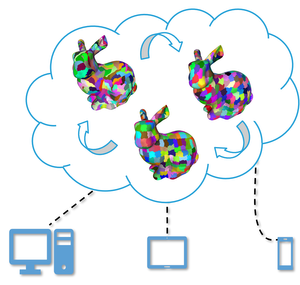Information
- Publication Type: Invited Talk
- Workgroup(s)/Project(s):
- Date: 7. July 2021
- Event: InnovWave 2021
- Location: online
- Open Access: no
- Keywords: cloud, real-time, rendering
Abstract
Mesh shading was recently introduced as a topical GPU feature in the NVIDIA Turing and AMD RDNA2 GPU architectures, offering an alternative pathway for executing the transformation, generation and augmentation of geometry for hardware rasterization. Future trends in game development will rely on mesh shading and “meshlets”, using highly detailed meshes with deep level of detail hierarchies. Particularly powerful applications of meshlets include arbtirary culling and subdivision methods. Furthermore, advanced pre-computation include visibility and lighting information that can be stored on a per-meshlet basis, thus promoting the compression of attributes through quantization and the acceleration of computations via hierarchical processing.Although meshlets can be comprised from arbitrary assemblages of primitives, their benefits are highest when meshlet formation is done in a way that already takes the usecase into account. Individual formation procedures can be defined in order to achieve specific goals. As an example, we may generate meshlets that are optimized for global illumination techniques, by minimizing their curvature and variance in material coefficients. Incoming light can then be ray-traced and cached per meshlet, along with view-dependent variance encoded in a discretized data structure. More uniform meshlets thus require less data transferred for accurately approximating their global illumination, reducing the consumption of critical memory bandwidth. We may also partition entire scenes into meshlets that foster fast visibility culling for large groups of primitives, without transforming even a single vertex. In fact, meshlet formation policies can leverage arbitrary attributes, such as the distribution of UV coordinates, ambient occlusion or mesh topology in order to optimize them according to desired runtime criteria. Cloud gaming offers a unique opportunity for leveraging this technology at a larger scale: dedicated data storages and servers can maintain multiple copies of complex triangle meshes, each partitioned by a particular meshlet formation policy. A live monitor can react to a specific bottleneck by dynamically switching meshlets to best accommodate the current GPU resource requirements. In this talk, we will present the various possibilities for real-time rendering to benefit from mesh shading by means of optimized meshlet formation procedures.
Additional Files and Images
Weblinks
No further information available.BibTeX
@talk{kerbl_2021_hdg,
title = "Providing Highly Detailed Geometry for Cloud and Edge
Real-Time Rendering",
author = "Bernhard Kerbl",
year = "2021",
abstract = "Mesh shading was recently introduced as a topical GPU
feature in the NVIDIA Turing and AMD RDNA2 GPU
architectures, offering an alternative pathway for executing
the transformation, generation and augmentation of geometry
for hardware rasterization. Future trends in game
development will rely on mesh shading and “meshlets”,
using highly detailed meshes with deep level of detail
hierarchies. Particularly powerful applications of meshlets
include arbtirary culling and subdivision methods.
Furthermore, advanced pre-computation include visibility and
lighting information that can be stored on a per-meshlet
basis, thus promoting the compression of attributes through
quantization and the acceleration of computations via
hierarchical processing. Although meshlets can be comprised
from arbitrary assemblages of primitives, their benefits are
highest when meshlet formation is done in a way that already
takes the usecase into account. Individual formation
procedures can be defined in order to achieve specific
goals. As an example, we may generate meshlets that are
optimized for global illumination techniques, by minimizing
their curvature and variance in material coefficients.
Incoming light can then be ray-traced and cached per
meshlet, along with view-dependent variance encoded in a
discretized data structure. More uniform meshlets thus
require less data transferred for accurately approximating
their global illumination, reducing the consumption of
critical memory bandwidth. We may also partition entire
scenes into meshlets that foster fast visibility culling for
large groups of primitives, without transforming even a
single vertex. In fact, meshlet formation policies can
leverage arbitrary attributes, such as the distribution of
UV coordinates, ambient occlusion or mesh topology in order
to optimize them according to desired runtime criteria.
Cloud gaming offers a unique opportunity for leveraging this
technology at a larger scale: dedicated data storages and
servers can maintain multiple copies of complex triangle
meshes, each partitioned by a particular meshlet formation
policy. A live monitor can react to a specific bottleneck by
dynamically switching meshlets to best accommodate the
current GPU resource requirements. In this talk, we will
present the various possibilities for real-time rendering to
benefit from mesh shading by means of optimized meshlet
formation procedures.",
month = jul,
event = "InnovWave 2021",
location = "online",
keywords = "cloud, real-time, rendering",
URL = "https://www.cg.tuwien.ac.at/research/publications/2021/kerbl_2021_hdg/",
}


